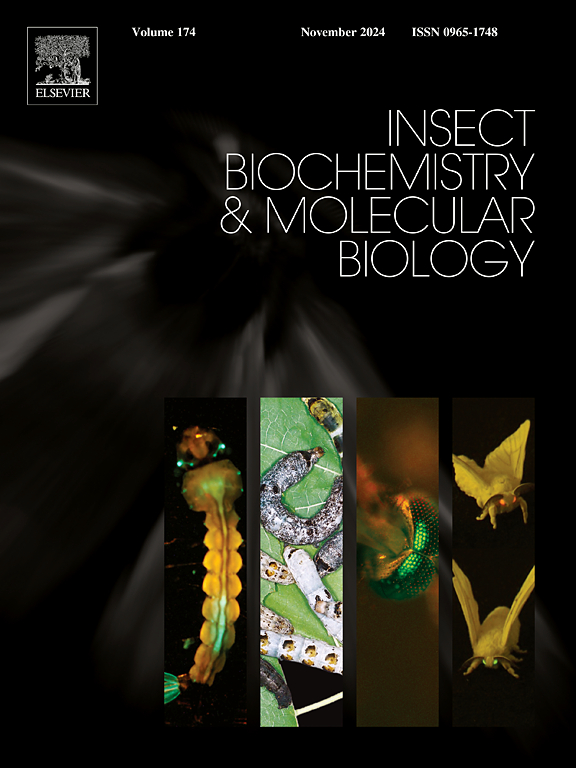The cys-loop ligand-gated ion channel gene superfamilies of the Lepidopteran species, Bombyx mori and Chilo suppressalis
IF 3.7
2区 农林科学
Q2 BIOCHEMISTRY & MOLECULAR BIOLOGY
引用次数: 0
Abstract
The rice stem borer, Chilo suppressalis (Walker), is a major pest of rice crops. It is commonly managed by pesticides, several of which act on cys-loop ligand-gated ion channels (cysLGICs). In insects, the cysLGIC superfamily consists of receptors that mediate fast excitatory or inhibitory synaptic transmission in the nervous system as well as performing non-neuronal roles. We present here the cysLGIC superfamily of C. suppressalis as well as that of the silk worm, Bombyx mori (Linnaeus), the first complete gene families from Lepidopteran species, which consists of 27 and 24 subunit-encoding genes, respectively. As with other insects, Chilo and Bombyx possess ion channels predicted to be gated by acetylcholine, γ-aminobutyric acid, glutamate and histamine, as well as orthologues of the Drosophila pH-sensitive chloride channel, CG8916 and CG12344. Both C. suppressalis and B. mori lack GRD (GABAA and glycine receptor-like subunit of Drosophila), instead possessing extra RDL (resistance to dieldrin) subunits. Quantitative polymerase chain reaction analysis showed that the C. suppressalis cysLGIC subunits can show differential expression levels throughout the insect's life cycle. Our findings reveal the complete cysLGIC gene families of B. mori and C. suppressalis. These findings enhance our understanding of the evolution of the insect cysLGIC superfamily and provide a useful basis for studying their function and action of pesticides.

鳞翅目、家蚕和家蚕的cys环配体门控离子通道基因超家族。
水稻茎螟虫是水稻作物的主要害虫。它们通常由农药控制,其中一些作用于cyslics环配体门控离子通道(cyslics)。在昆虫中,cyyslgic超家族由介导神经系统中快速兴奋性或抑制性突触传递以及执行非神经元角色的受体组成。我们在此提出了C. suppressalis和家蚕(Linnaeus)的cyyslic超家族,这是鳞翅目物种中第一个完整的基因家族,分别由27个和24个亚单位编码基因组成。与其他昆虫一样,红家蚕和家蚕具有乙酰胆碱、γ-氨基丁酸、谷氨酸和组胺门控的离子通道,以及果蝇ph敏感氯通道CG8916和CG12344的同源物。C. suppressalis和B. mori都缺乏GRD(果蝇的GABAA和甘氨酸受体样亚基),而具有额外的RDL(对狄氏剂的抗性)亚基。定量聚合酶链反应分析表明,抑孢假丝酵素亚基在整个昆虫生命周期中表现出不同的表达水平。我们的发现揭示了家蚕和抑制家蚕的完整的cyyslgic基因家族。这些发现增强了我们对昆虫yslgic超家族进化的认识,并为研究其功能和农药作用提供了有益的基础。
本文章由计算机程序翻译,如有差异,请以英文原文为准。
求助全文
约1分钟内获得全文
求助全文
来源期刊
CiteScore
7.40
自引率
5.30%
发文量
105
审稿时长
40 days
期刊介绍:
This international journal publishes original contributions and mini-reviews in the fields of insect biochemistry and insect molecular biology. Main areas of interest are neurochemistry, hormone and pheromone biochemistry, enzymes and metabolism, hormone action and gene regulation, gene characterization and structure, pharmacology, immunology and cell and tissue culture. Papers on the biochemistry and molecular biology of other groups of arthropods are published if of general interest to the readership. Technique papers will be considered for publication if they significantly advance the field of insect biochemistry and molecular biology in the opinion of the Editors and Editorial Board.

 求助内容:
求助内容: 应助结果提醒方式:
应助结果提醒方式:


